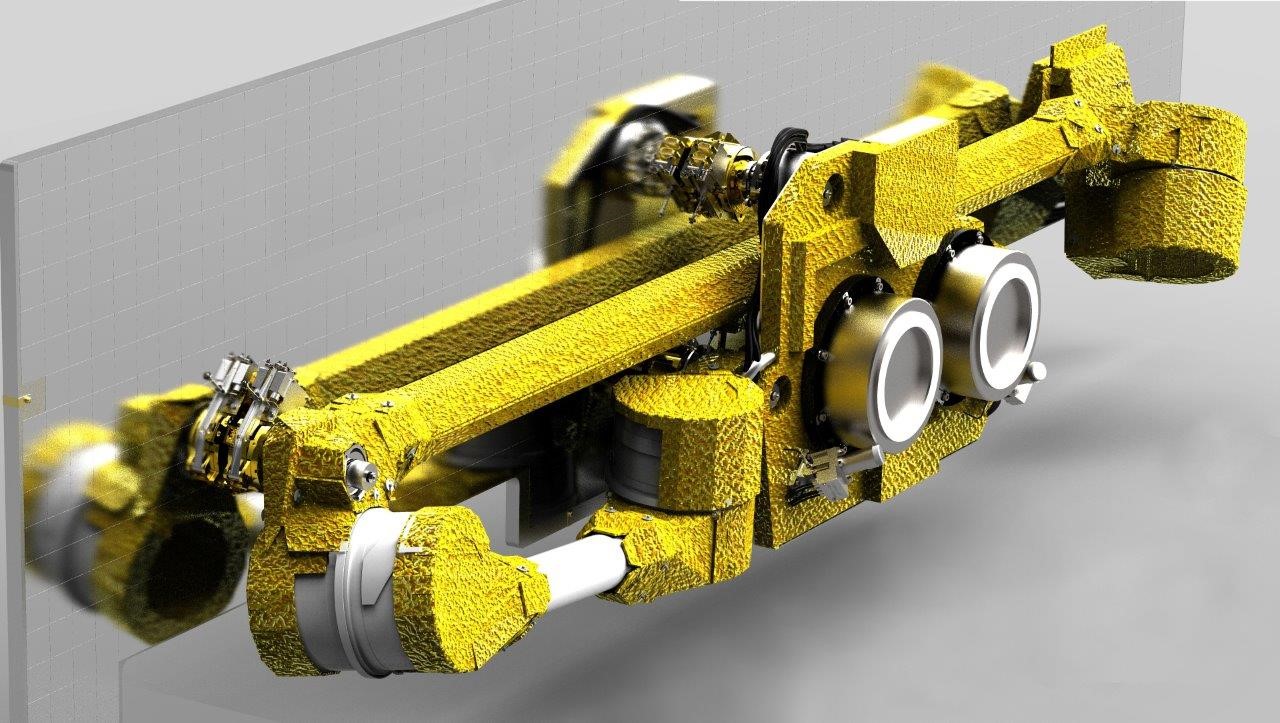
-
StatusCompleted
-
Status date2019-09-23
-
Activity Code4B.103
The P-DPS is part of Airbus All-electric propulsion system for telecommunication satellites for Electric Orbit Raising (EOR).
The EOR satellite design uses the benefit of replacing chemical propulsion reservoir with lower size gas reservoir.
This allows to increase the payload mass over the overall satellite mass.
The lower mass and electric propulsion allows the use of cheaper launchers.
The continuous and low power electric propulsion is used for Orbit raising which can take from 4 to 6 months to reach station.
The DPS is used for the first European all electric satellites
The deployable system uses the robotic arm to position the propulsion vector in the optimum position and adjust to CoG movement in station.
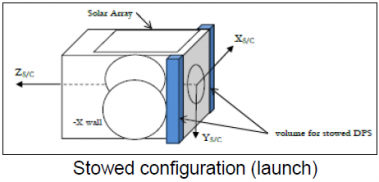

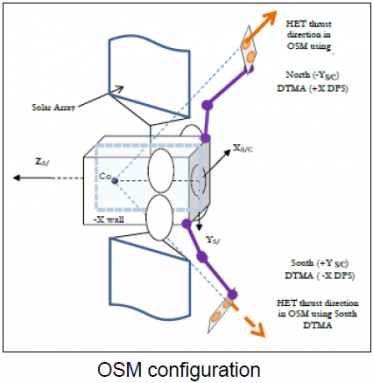
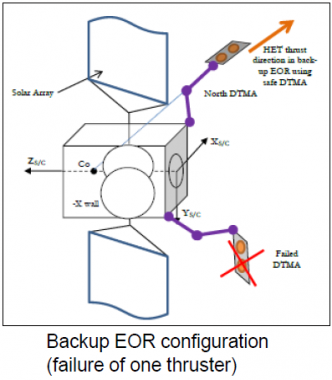
The key design issues currently reside with the pointing mechanism development. The P-DPS offers a robust configuration capable of supporting different Hall Effect thruster variants.
The P-DPS deployable building blocks are also designed to be (in the future) compatible for antenna deployment.
The P-DPS is a critical component for the mission execution. As such, it must propose a robust and reliable solution to ensure flawless mission executions while ensuring a clear mass gain justifying its competitiveness compared to existing solutions.
To meet this goal the P-DPS structure and single components must be thoroughly tested and meticulously designed, manufactured assembled and tested.
When compared to existing thruster module assemblies, the benefits of the P-DPS may be listed as:
- Offers mass benefits for any given thruster payload
- Supports a wide range of thruster variants
- Enabler for full electrical telecom satellite
- Modular, completely self-contained assembly
- Low shock, non-explosive release of the launch lock assembly
- Benign load transfer function
- Proven actuating life
- Competitive cost compared closely to currently existing thruster pointing system proposed solutions, through a standardized and multi-application building block approach.
The Extendable Thruster Pointing Mechanism, aims at enhancing the overall competitiveness and performance of E3000 satellites in order to fully answer operators’ needs and requirements. The recent introduction of much cheaper launcher for low/medium launch masses created an economic opportunity to extend the use of PPS on a much wider range of payload.
The use of EOR (Electric Orbit Rising) instead of chemical propulsion for the transfer phase allows reducing propellant mass, and therefore to increase the maximum allowable spacecraft dry mass.
The Extendable Thruster Pointing Mechanisms are one of the main enablers allowing an intensive and efficient use of electric propulsion on Eurostar 3000 telecommunications satellites, both for the orbit raising phase (EOR) and the station keeping manoeuvers.
As a consequence, it contributes to Eurostar 3000 competitiveness allowing AIRBUS DS to:
- Propose a reduced cost per transponder
- Access to a larger range of launchers, with cheaper launch costs
The proposed Extendable Thruster Pointing Mechanisms allow :
- To minimize the orbit raising duration, this phase being done with the maximum possible thrust, with all HET oriented towards the same direction (satellite Z-axis).
- To optimize the station keeping strategies with both a better North-South station keeping efficiency and the ability to perform East-West station keeping and angular momentum control.
The missions of the Extendable Thruster Pointing Mechanisms are to deploy and point a payload supporting Hall-Effect Thrusters (HET), and to allow the HET operation in various phases of the mission.
Its mission is decomposed in several phases:
- Launch in stowed configuration, clamped on the Satellite Service Module Y walls.
- Release & Deployment : this phase occurs during the first hours of mission.
- Orbit raising, in a configuration with the thruster force direction along Zsat. The Hall Effect Thrusters are operated with the P-DPS pointing mechanisms operating in closed loop for control of satellite angular momentum.
- Operational Mission: after reconfiguration such that the thruster force direction is close to Y-sat and aligned with the centre of mass, the HET are operated for station keeping manoeuvres, with the DPS pointing mechanisms operating in closed loop for control of the satellite angular momentum. These manoeuvres allow performing the control of inclination, longitude and eccentricity, and control of the angular momentum.
The P-DPS is launched in a stowed configuration, locked in position by a Hold Down Release Mechanism. The HDRM is released after the launcher separation by a low shock, non-explosive device.
The extendable pointing mechanism is then deployed to its thrust position through a defined sequence. Once deployed, the thruster module can be re-positioned using the complete capacity of its rotating compact hinges. The hinges are driven by stepper motors powered from the onboard control electronics.
The Xenon fuel is routed through the P-DPS through a low pressure line to the thruster module assembly in any pointing position with a careful care to its thermal environment and space environment protection.
This program consisted of three successive phases.
Phase 1 : Preliminary Design and Breadboard Phase
Preliminary design of the P-DPS supported by functional BB tests results.
Phase 2 : Detailed Design and Validation Phase
Detailed design of the P-DPS supported by validation tests results on Engineering Models.
Objective : thermal design and mechanical evaluation based on the most conservative environment of antenna and propulsion applications.
Phase 2 final Milestone is the Critical Design Review.
Phase 3 : Proto-Flight and Recurring Production Phase
Manufacturing and testing of Flight Models (including a PFM approach for the first flight set funded under an ARTES C & G Demonstration Phase – Atlas case).
Phase 3 final Milestone is the Validation Review.
The three development phases described here above are now completed.
All contractual Milestones have been pronounced successful and the associated documentation delivered.
7 P-DPS Flight Sets have been already delivered by EHP to Airbus DS, and three of them have been already launched successfully.
1 more P-DPS Flight Sets is currently being assembled by EHP.
The In-Orbit Tests (IOT) performed on the Atlas case Flight Set have been presented to ESA in May 2019 during the Commissioning Results Review.
The results showed no anomaly. Both P-DPS were working perfectly.
The results of the P-DPS activities after one year in orbit have been presented to ESA in June 2020 during the Final Review.
The results showed no anomaly. Both P-DPS are working perfectly.
Here are some pictures to illustrate the P-DPS life.

P-DPS Vibrations Tests
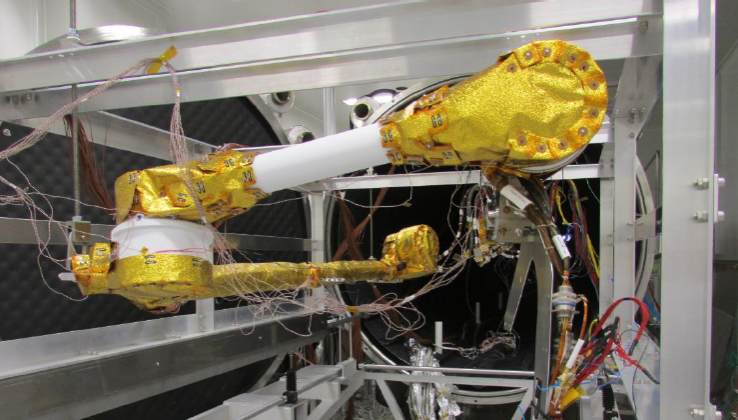
P-DPS TVAC Tests
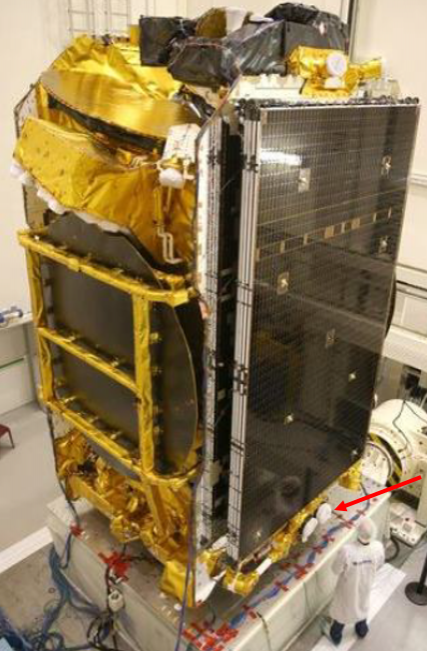
P-DPS being assembled on satellite. ©Airbus.
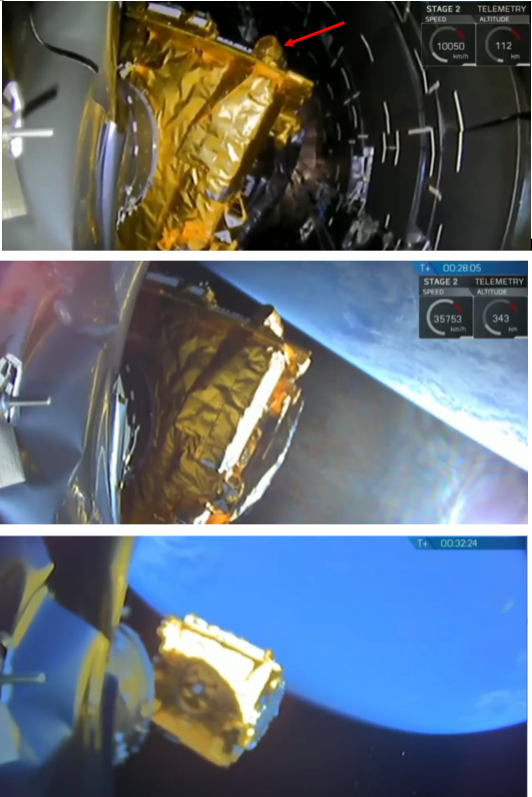
Satellite being ejected from the launcher, beginning of June 2018.©SpaceX.
One P-DPS is visible on the side of the upper wall.




